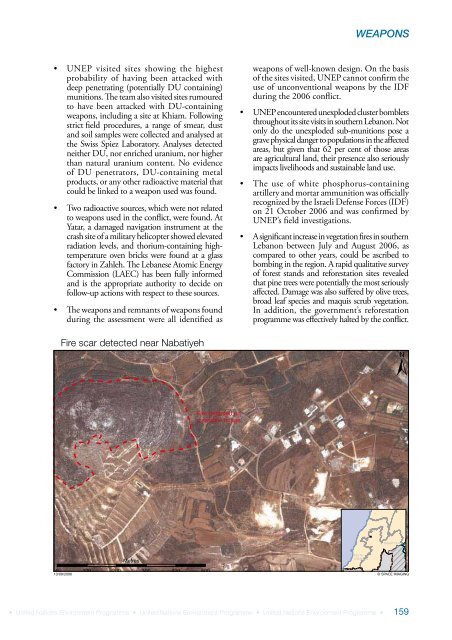Lebanon Post-Conflict Environmental Assessment - UNEP
Lebanon Post-Conflict Environmental Assessment - UNEP
Lebanon Post-Conflict Environmental Assessment - UNEP
Create successful ePaper yourself
Turn your PDF publications into a flip-book with our unique Google optimized e-Paper software.
WEAPONS• <strong>UNEP</strong> visited sites showing the highestprobability of having been attacked withdeep penetrating (potentially DU containing)munitions. The team also visited sites rumouredto have been attacked with DU-containingweapons, including a site at Khiam. Followingstrict field procedures, a range of smear, dustand soil samples were collected and analysed atthe Swiss Spiez Laboratory. Analyses detectedneither DU, nor enriched uranium, nor higherthan natural uranium content. No evidenceof DU penetrators, DU-containing metalproducts, or any other radioactive material thatcould be linked to a weapon used was found.• Two radioactive sources, which were not relatedto weapons used in the conflict, were found. AtYatar, a damaged navigation instrument at thecrash site of a military helicopter showed elevatedradiation levels, and thorium-containing hightemperatureoven bricks were found at a glassfactory in Zahleh. The Lebanese Atomic EnergyCommission (LAEC) has been fully informedand is the appropriate authority to decide onfollow-up actions with respect to these sources.• The weapons and remnants of weapons foundduring the assessment were all identified asweapons of well-known design. On the basisof the sites visited, <strong>UNEP</strong> cannot confirm theuse of unconventional weapons by the IDFduring the 2006 conflict.• <strong>UNEP</strong> encountered unexploded cluster bombletsthroughout its site visits in southern <strong>Lebanon</strong>. Notonly do the unexploded sub-munitions pose agrave physical danger to populations in the affectedareas, but given that 62 per cent of those areasare agricultural land, their presence also seriouslyimpacts livelihoods and sustainable land use.• The use of white phosphorus-containingartillery and mortar ammunition was officiallyrecognized by the Israeli Defense Forces (IDF)on 21 October 2006 and was confirmed by<strong>UNEP</strong>’s field investigations.• A significant increase in vegetation fires in southern<strong>Lebanon</strong> between July and August 2006, ascompared to other years, could be ascribed tobombing in the region. A rapid qualitative surveyof forest stands and reforestation sites revealedthat pine trees were potentially the most seriouslyaffected. Damage was also suffered by olive trees,broad leaf species and maquis scrub vegetation.In addition, the government’s reforestationprogramme was effectively halted by the conflict.Fire scar detected near NabatiyehFire detected ona satellite imageNABATYEHMetres0 100 200 300 400 50010/09/2006 © SPACE IMAGINGSOUTHLEBANON• United Nations Environment Programme • United Nations Environment Programme • United Nations Environment Programme •159
















